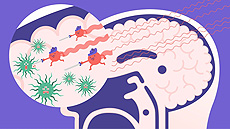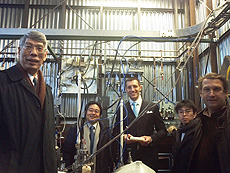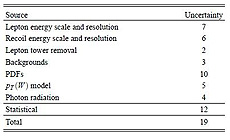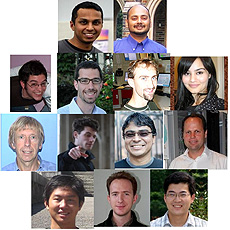|
Thursday, Jan. 16
- Breakfast: Canadian bacon, egg and cheese Texas toast
- Breakfast: Mexican omelet
- Steak soft tacos
- Smart cuisine: spinach and jack cheese enchiladas
- Chicken parmesan
- Grilled-vegetable sandwich
- Sweet and sour chicken
- Beef barley soup
- Chef's choice soup
- Assorted pizza by the slice
Wilson Hall Cafe menu |
|
Friday, Jan. 17
Dinner
- Zucchini fritters with yogurt dill sauce
- Filet mignon with cabernet sauce
- Peppery baked onions with sage and gruyere
- Smashed potatoes
- Espresso crème brûlée
Wednesday, Jan. 22
Lunch
- Chicken marsala with fettuccini
- Caesar salad
- Italian cream cake
Chez Leon menu
Call x3524 to make your reservation.
|
|
Particle accelerators join fight against brain cancer
 |
Accelerator technology could be key to developing an effective treatment for a type of brain tumor currently considered incurable. Image: Sandbox Studio |
One of the most common and aggressive types of malignant tumor originating in the human brain is called a glioblastoma multiforme. Patients diagnosed with this kind of tumor are told they have, on average, a little more than a year to live.
Because standard treatments, including surgery and radiation therapy, cannot completely eradicate glioblastomas without fatally damaging the surrounding healthy tissue, these tumors are considered incurable. But Narayan Hosmane, a boron chemist from Northern Illinois University, is working with a team of scientists from Fermilab to try to rid them of that classification.
The group is exploring the capabilities of an experimental treatment called boron neutron capture therapy. The key to making BNCT work, they think, could lie in particle accelerator technology.
Daniel Silbergeld, a University of Washington neurosurgery and neuropathology professor based at UW Medical Center and Harborview Medical Center in Seattle, operates on more than 200 tumors in a year, at least half of which are glioblastomas.
"Our goal is to help that person live as long as possible and as well as possible," Silbergeld says. "We never know how well an individual is going to do."
Silbergeld, who is an affiliate of Seattle Cancer Care Alliance, says patients who undergo aggressive therapy tend to be the ones who live longer.
Here's an overview of how BNCT works: A medical professional injects into the patient's bloodstream a tumor-seeking compound containing non-radioactive boron. Normally, blood does not come in contact with the brain, thanks to a bodily structure called the blood-brain barrier. But due to the relatively low molecular weight of the compound and the fact that tumors often compromise the blood-brain barrier anyway, the drug can bypass this membrane and enter the glioblastoma, which is filled with blood vessels. The drug accumulates there and in some of the surrounding tissue.
Read more
—Sarah Witman
|
A visit to the LBNE cryostat
 |
| Representatives from the industrial firm IHI Inc. in New York visit Fermilab to see the 35-ton prototype cryostat for the Long-Baseline Neutrino Experiment. IHI Corporation, parent company of IHI Inc. and based in Japan, designed and supplied the membrane for the cryostat and the technical supervision during the installation. Fermilab technicians built the cryostat. From left: Senior Vice President Keiichi lshikane (IHI), Executive Vice President and Chief Operating Officer Tsutomu Yoshida (IHI), LBNE Lead Cryostat Engineer David Montanari (Fermilab), Manager for Technical Research and Business Development Yuichi Nishiyama (IHI), LBNE Far-Detector Project Manager Jim Stewart (Brookhaven Lab). The LBNE collaboration recently filled the cryostat with liquid argon, the material that will allow scientists to observe neutrino interactions. Stay tuned for more on the LBNE cryostat in a future Fermilab Today article. |
|
Fermilab's NOvA experiment
From Chicago Tonight, Jan. 14, 2014
Editor's note: This article includes Chicago Tonight's 5-minute video broadcast on the NOvA near detector.
One of the ironies of modern science is that increasingly bigger experiments are required to better understand the smallest of particles. That's the case with a new machine at Fermilab in far west suburban Batavia. Physicists there have just completed installing one of the largest particle detectors in the world, and it's working in conjunction with another detector 500 miles away to try to unlock the mysteries of the neutrino.
Weighing in at nearly 13 tons, it took scientists and technicians at Fermilab more than a little effort to get a massive block into place. They had to make adjustments, realignments, and do a bit of finagling to get it in the right spot.
But when they eventually got it there, they completed a machine containing six other equally gigantic blocks. All together, they form a particle detector that soon will try to unravel one of the great mysteries of the universe.
Read more
Photo gallery
|
FY 2014 appropriations: DOE Office of Science
From FYI: The AIP Bulletin of Science Policy News, Jan. 14, 2014
The FY 2014 appropriations cycle is coming to a close. Yesterday evening the text of an almost 1,600 page bill was released that was the product of intense negotiations between the House and Senate Appropriations Committees since a budget agreement was announced in December. The omnibus bill, consisting of twelve separate appropriations bills, is expected to pass the House and Senate and sent to President Obama within the next few days.
Read more
|
|
CDF documentation for the W boson mass measurement
 |
| Uncertainties in units of MeV/c2 on the latest result for the mass of the W boson, which was determined to be 80,387 ± 19 MeV/c2. The total uncertainty amounts to 0.02 percent. |
On Feb. 29, 2012, CDF submitted to the journal Physical Review Letters the world's most precise measurement of the W boson mass. More recently, on Nov. 4, 2013, we submitted a long paper to Physical Review D documenting this measurement in detail. This has long been a practice at CDF: making important results available quickly and then proceeding to document them carefully so that physicists can really understand what was done.
Discovered at CERN in 1983, the W boson is one of the particles responsible for mediating electroweak interactions. Among other decay paths, it can decay into an electron or muon and a neutrino.
In Tevatron Run I (1990), using 1,722 W bosons, we determined the W boson mass to be 79,910 ± 390 MeV/c2. Between Run I and Run II, we completely rebuilt all of the tracking chambers, which would help in making a more accurate measurement. Thanks to the Accelerator Division, the Tevatron's beam luminosity increased, and thus in 2007 we announced a new measurement based on more than 60 times the number of W boson events from 1990, helping significantly diminish the uncertainty of 390 MeV/c2. We found the mass to be 80,413 ± 48 MeV/c2 based on 115,092 events. At the time, this was the world's single most precise measurement of the W mass.
For the 2012 measurement, our goal was to reduce the 48 MeV/c2 uncertainty to below that of the previous world average of 23 MeV/c2.
The largest single systematic uncertainty in this measurement was ± 23 MeV/c, which was the uncertainty on the calibration of the momentum of the decay electron and muon. The collaboration improved the calibration of the electron energy scale using, in decays of both the W and the Z boson, the ratio of its energy to its momentum. We verified this calibration technique by applying it to the measurement of the mass of the Z boson decaying into two electrons. We established the momentum calibration using J/ψ- and Υ-to-muon pair decays and again verified it using the Z-to-muon pair mass measurement. In the current measurement, the uncertainty of the electron and muon energy scale is reduced to ± 7 MeV/c2 (see top figure).
The February 2012 measurement of the W boson mass from CDF is 80,387 ± 19 MeV/c2, which was obtained using 470,126 candidates in which a W decays into an electron and a neutrino and 624,708 candidates in which a W decays into a muon and a neutrino. The combined world average now yields a W boson mass of 80,385 ± 15 MeV/c2.
What has changed since February 2012? The Higgs boson has been discovered, and its mass has been determined to high accuracy, allowing a prediction of the W boson mass of
80,359 ± 11 MeV/c2. The comparison of this prediction with the combined world average places bounds on non-Standard Model physics.
What next? CDF is analyzing four times more data to try to achieve a precision of about 10 MeV/c2. It is a challenging target. Stay tuned!
Learn more
—edited by Andy Beretvas
 |
| These physicists were responsible for this analysis.
Top row from left: Bodhitha Jayatilaka, Fermilab; Ashutosh Kotwal, Duke University;
Second row: Daniel Beecher, University College, London; Ilija Bizjak, University College,
London; Chris Hays, Oxford University; Sarah Malik, Rockefeller University.
Third row: Peter Renton, Oxford University; Tom Riddick, University College, London; Ravi Shekhar, Duke University; Oliver Stelzer-Chilton, TRIUMF.
Fourth row: Siyuan Sun, Duke University; Dave Waters, University College, London; Yu Zeng, Duke University.
|
|
|